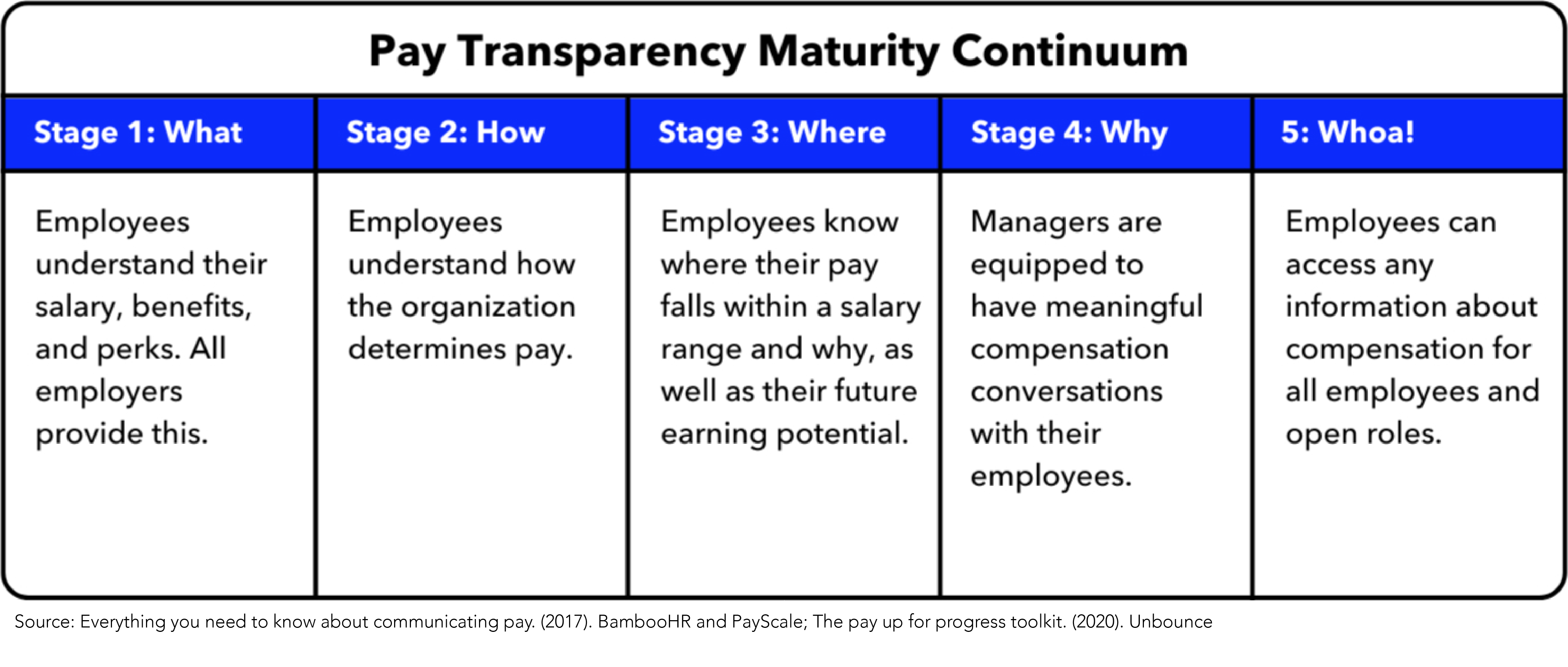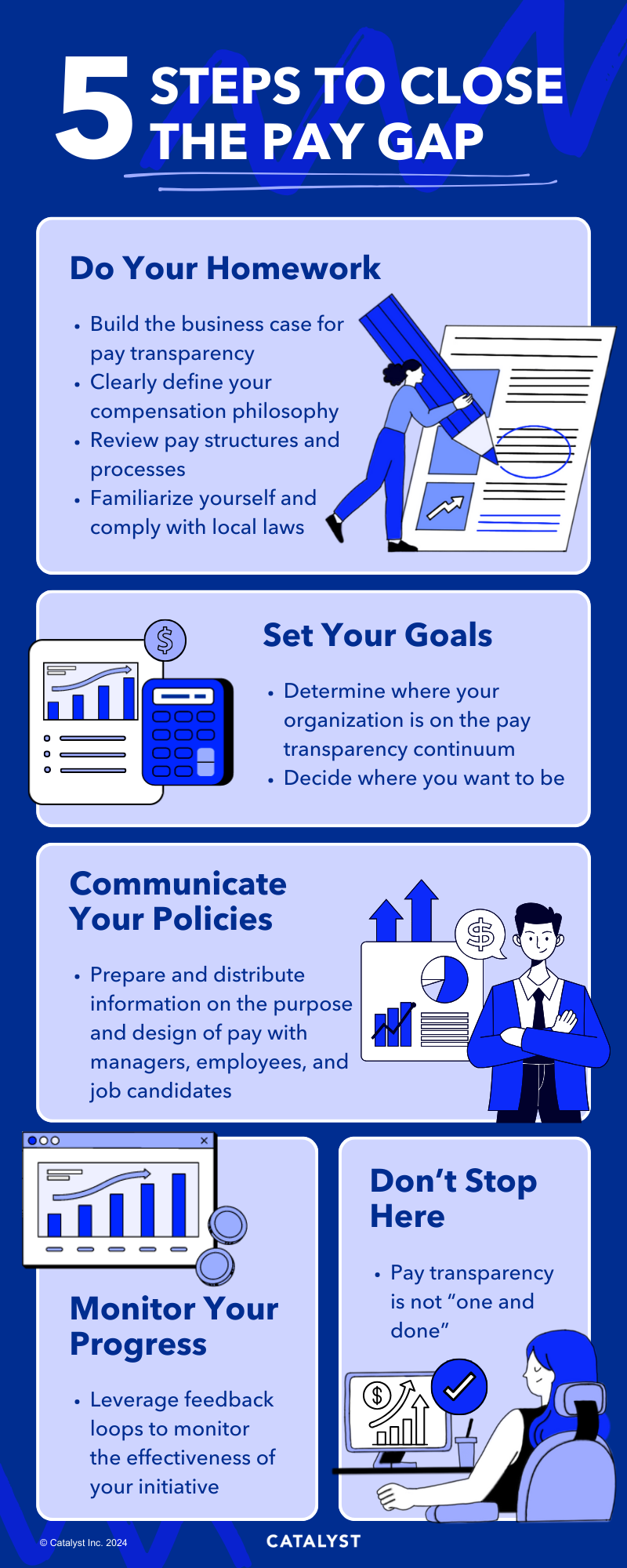Equal pay starts with pay transparency: Step-by-step guide for HR leaders
4 min read
|
Part 2 of 2
Missed Part 1? Read it now: HR, Take Note: Employees Want Pay Transparency. Smart Companies Are Listening
Each year on Equal Pay Day in the United States, Catalyst reflects on how much longer women must work to reach the same earnings made by men the previous year. We know that the gender wage gap persists across the world and that its impact is intensified when considering intersecting identities such as age, race, and ethnicity.1 What can we do about it? Pay transparency offers a path forward. In Part 1 of this series, we documented pay transparency's role in reducing wage gaps, building employee trust and engagement, and helping employers better evaluate performance. Critically, pay transparency practices lay the groundwork for fairer organizational processes, including pay equity reviews, which are rapidly becoming standard practice at leading organizations like the Catalyst CEO Champions For Change.
So, HR leaders: Are you ready to implement pay transparency at your organization? The journey to pay transparency can be complex, but there are a few simple steps you can take to get started today.
Do your homework.
Build the fairness case for pay transparency. Emphasize pay transparency’s critical role in cultivating organizational fairness, as it addresses longstanding pay inequities and reinforces accountability mechanisms. Pay transparency may also align with your organization’s mission and values. The fairness case especially resonates with employees: Catalyst research found that when companies spotlight the fairness case for diversity, equity, and inclusion (DEI), employees report enhanced experiences of inclusion, view their organization as fair and meritocratic, and increase their intentions to stay.2Build the business case for pay transparency. We’ve established that pay transparency brings tangible advantages to organizations. Be prepared to have difficult conversations with senior leaders who might be resistant to change. The business case should clearly link the benefits of pay transparency to your talent, total rewards, and DEI strategies—in particular, the reduction of the pay gap among women and marginalized communities. Define your organization’s compensation philosophy. How do compensation and rewards relate to roles? Pinpoint specific skills, knowledge, experiences, responsibilities, expectations, and market value for each role to set appropriate and competitive salary ranges. 3Review your pay structures and processes. Go back to the basics with your approach to pay, examining your job architecture, pay strategy, pay equity, existing communications with employees, salary bands, and employee perceptions around pay. 4Familiarize yourself and comply with local laws. Ready or not, the number of pay transparency laws is increasing across the world. They often require employers to disclose compensation expectations to job applicants, provide salary bands to existing employees, and/or disclose pay gaps to local regulators. At a minimum, organizations must know about and meet their legal obligations.5
Set your goals.
Evaluate your current approach to pay transparency, and where you would like to be. Consider the following pay transparency maturity continuum created by BambooHR and PayScale.6 Set realistic goals based on where you are on the continuum and the stage you aim to achieve.

Communicate your policies.
Prepare and distribute information on the purpose and design of pay with managers, employees, and job candidates.7 This includes information on compensation itself (salary bands, benefits, perks, bonuses, incentives, and more), the organization’s compensation philosophy and strategy, the factors that determine pay, the current level of pay transparency, and any laws or regulations that impact a given position. Recruiters and managers should have the tools they need for productive conversations about pay, including how to communicate pay equity analyses and corrections. 8 In job postings, avoid setting extremely wide salary ranges that confuse job seekers and could be perceived as mocking pay transparency laws.9
Monitor your progress.
Leverage feedback loops—such as employee engagement, DEI, or candidate surveys—to monitor the effectiveness of your pay transparency initiative.10 Assess whether individuals cite pay transparency as a factor in their decisions to join or stay with the organization, and disaggregate the findings by gender, race/ethnicity, and other marginalized groups to understand how these interventions are impacting them.
Don't stop here!
Pay transparency is not a “one-and-done” exercise. This work requires continual evaluation and refinement to ensure a true and sustainable culture of transparency. Recent Catalyst Award winners The Hartford and Boston Scientific offer examples of leading companies that implemented pay transparency and centered inclusion and a commitment to closing pay gaps in their approach.
This Equal Pay Day, we encourage you to take a step forward in making our workplaces fairer, more accountable, and more equitable by modeling a culture of transparency.
Endnotes
- Women’s earnings – The pay gap: Quick Take. (July 5, 2023). Catalyst
- Shaffer, E. & Torrez, B. (2024). How to talk about diversity with employees to achieve your company’s objectives. Catalyst.
- Monroe, A. (2023, May 31). How companies can respond to new salary transparency laws. SHRM.
- Navigating the pay transparency journey [Infographic]. (2020). Mercer.
- To learn more about pay transparency and pay equity laws in the United States, Canada, and the EU, respectively, see: Marfice, C. (2024). Pay transparency laws: A state-by-state guide. Rippling; Monsma, L., VanDerMeulen, J., & Arseneault, S. (2023, March 30). Pay transparency: A growing trend. Fasken; Pay transparency in the EU. (2023). European Council and Council of the European Union.
- Everything you need to know about communicating pay. (2017). BambooHR and PayScale; The pay up for progress toolkit. (2020). Unbounce.
- Navigating the pay transparency journey [Infographic]. (2020). Mercer.
- Matuson, R. (2022, November 28). Managers, are you prepared to answer questions about pay equity? Harvard Business Review; Getting started with pay equity (Practices). (2022). Catalyst.
- Kelly, J. (2023, June 6). Companies posting wide salary ranges on job advertisements are making a mockery of pay transparency laws. Forbes.
- Navigating the pay transparency journey [Infographic]. (2020). Mercer.
